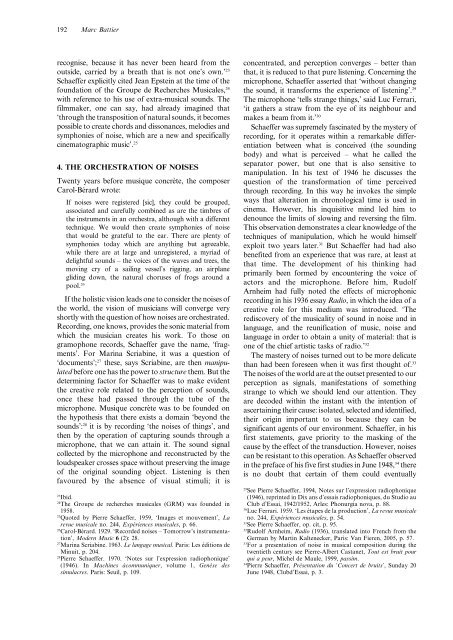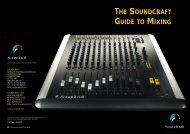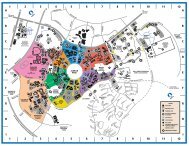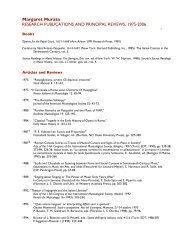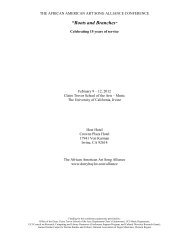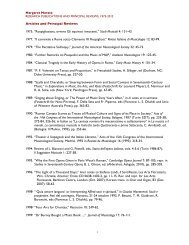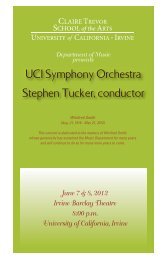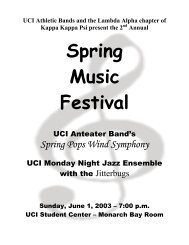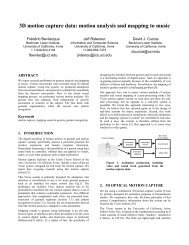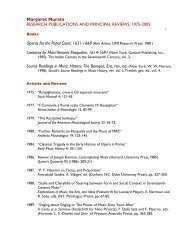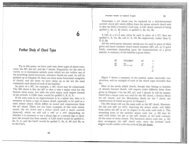What the GRM brought to music: from musique concre`te to ...
What the GRM brought to music: from musique concre`te to ...
What the GRM brought to music: from musique concre`te to ...
Create successful ePaper yourself
Turn your PDF publications into a flip-book with our unique Google optimized e-Paper software.
192 Marc Battierrecognise, because it has never been heard <strong>from</strong> <strong>the</strong>outside, carried by a breath that is not one’s own.’ 23Schaeffer explicitly cited Jean Epstein at <strong>the</strong> time of <strong>the</strong>foundation of <strong>the</strong> Groupe de Recherches Musicales, 24with reference <strong>to</strong> his use of extra-<strong>music</strong>al sounds. Thefilmmaker, one can say, had already imagined that‘through <strong>the</strong> transposition of natural sounds, it becomespossible <strong>to</strong> create chords and dissonances, melodies andsymphonies of noise, which are a new and specificallycinema<strong>to</strong>graphic <strong>music</strong>’. 254. THE ORCHESTRATION OF NOISESTwenty years before <strong>musique</strong> concrète, <strong>the</strong> composerCarol-Bérard wrote:If noises were registered [sic], <strong>the</strong>y could be grouped,associated and carefully combined as are <strong>the</strong> timbres of<strong>the</strong> instruments in an orchestra, although with a differenttechnique. We would <strong>the</strong>n create symphonies of noisethat would be grateful <strong>to</strong> <strong>the</strong> ear. There are plenty ofsymphonies <strong>to</strong>day which are anything but agreeable,while <strong>the</strong>re are at large and unregistered, a myriad ofdelightful sounds – <strong>the</strong> voices of <strong>the</strong> waves and trees, <strong>the</strong>moving cry of a sailing vessel’s rigging, an airplanegliding down, <strong>the</strong> natural choruses of frogs around apool. 26If <strong>the</strong> holistic vision leads one <strong>to</strong> consider <strong>the</strong> noises of<strong>the</strong> world, <strong>the</strong> vision of <strong>music</strong>ians will converge veryshortly with <strong>the</strong> question of how noises are orchestrated.Recording, one knows, provides <strong>the</strong> sonic material <strong>from</strong>which <strong>the</strong> <strong>music</strong>ian creates his work. To those ongramophone records, Schaeffer gave <strong>the</strong> name, ‘fragments’.For Marina Scriabine, it was a question of‘documents’; 27 <strong>the</strong>se, says Scriabine, are <strong>the</strong>n manipulatedbefore one has <strong>the</strong> power <strong>to</strong> structure <strong>the</strong>m. But <strong>the</strong>determining fac<strong>to</strong>r for Schaeffer was <strong>to</strong> make evident<strong>the</strong>creativerolerelated<strong>to</strong><strong>the</strong>perceptionofsounds,once <strong>the</strong>se had passed through <strong>the</strong> tube of <strong>the</strong>microphone. Musique concrète was <strong>to</strong> be founded on<strong>the</strong> hypo<strong>the</strong>sis that <strong>the</strong>re exists a domain ‘beyond <strong>the</strong>sounds’: 28 it is by recording ‘<strong>the</strong> noises of things’, and<strong>the</strong>n by <strong>the</strong> operation of capturing sounds through amicrophone, that we can attain it. The sound signalcollected by <strong>the</strong> microphone and reconstructed by <strong>the</strong>loudspeaker crosses space without preserving <strong>the</strong> imageof <strong>the</strong> original sounding object. Listening is <strong>the</strong>nfavoured by <strong>the</strong> absence of visual stimuli; it is23Ibid.24The Groupe de recherches <strong>music</strong>ales (<strong>GRM</strong>) was founded in1958.25Quoted by Pierre Schaeffer, 1959, ‘Images et mouvement’, Larevue <strong>music</strong>ale no. 244, Expériences <strong>music</strong>ales, p. 66.26Carol-Bérard. 1929. ‘Recorded noises – Tomorrow’s instrumentation’,Modern Music 6 (2): 28.27Marina Scriabine. 1963. Le langage <strong>music</strong>al. Paris: Les éditions deMinuit, p. 204.28Pierre Schaeffer. 1970. ‘Notes sur l’expression radiophonique’(1946). In Machines àcommuniquer, volume 1, Genèse dessimulacres. Paris: Seuil, p. 109.concentrated, and perception converges – better thanthat, it is reduced <strong>to</strong> that pure listening. Concerning <strong>the</strong>microphone, Schaeffer asserted that ‘without changing<strong>the</strong> sound, it transforms <strong>the</strong> experience of listening’. 29The microphone ‘tells strange things,’ said Luc Ferrari,‘it ga<strong>the</strong>rs a straw <strong>from</strong> <strong>the</strong> eye of its neighbour andmakes a beam <strong>from</strong> it.’ 30Schaeffer was supremely fascinated by <strong>the</strong> mystery ofrecording, for it operates within a remarkable differentiationbetween what is conceived (<strong>the</strong> soundingbody) and what is perceived – what he called <strong>the</strong>separa<strong>to</strong>r power, but one that is also sensitive <strong>to</strong>manipulation. In his text of 1946 he discusses <strong>the</strong>question of <strong>the</strong> transformation of time perceivedthrough recording. In this way he invokes <strong>the</strong> simpleways that alteration in chronological time is used incinema. However, his inquisitive mind led him <strong>to</strong>denounce <strong>the</strong> limits of slowing and reversing <strong>the</strong> film.This observation demonstrates a clear knowledge of <strong>the</strong>techniques of manipulation, which he would himselfexploit two years later. 31 But Schaeffer had had alsobenefited <strong>from</strong> an experience that was rare, at least atthat time. The development of his thinking hadprimarily been formed by encountering <strong>the</strong> voice ofac<strong>to</strong>rs and <strong>the</strong> microphone. Before him, RudolfArnheim had fully noted <strong>the</strong> effects of microphonicrecording in his 1936 essay Radio,inwhich<strong>the</strong>ideaofacreative role for this medium was introduced. ‘Therediscovery of <strong>the</strong> <strong>music</strong>ality of sound in noise and inlanguage, and <strong>the</strong> reunification of <strong>music</strong>, noise andlanguage in order <strong>to</strong> obtain a unity of material: that isoneof<strong>the</strong>chiefartistictasksofradio.’ 32The mastery of noises turned out <strong>to</strong> be more delicatethan had been foreseen when it was first thought of. 33The noises of <strong>the</strong> world are at <strong>the</strong> outset presented <strong>to</strong> ourperception as signals, manifestations of somethingstrange <strong>to</strong> which we should lend our attention. Theyare decoded within <strong>the</strong> instant with <strong>the</strong> intention ofascertaining <strong>the</strong>ir cause: isolated, selected and identified,<strong>the</strong>ir origin important <strong>to</strong> us because <strong>the</strong>y can besignificant agents of our environment. Schaeffer, in hisfirst statements, gave priority <strong>to</strong> <strong>the</strong> masking of <strong>the</strong>cause by <strong>the</strong> effect of <strong>the</strong> transduction. However, noisescan be resistant <strong>to</strong> this operation. As Schaeffer observedin <strong>the</strong> preface of his five first studies in June 1948, 34 <strong>the</strong>reis no doubt that certain of <strong>the</strong>m could eventually29See Pierre Schaeffer, 1994, Notes sur l’expression radiophonique(1946), reprinted in Dix ans d’essais radiophoniques, du Studio auClub d’Essai, 1942/1952, Arles: Phonurgia nova, p. 88.30Luc Ferrari. 1959. ‘Les étapes de la production’, La revue <strong>music</strong>aleno. 244, Expériences <strong>music</strong>ales, p. 54.31See Pierre Schaeffer, op. cit, p. 95.32Rudolf Arnheim, Radio (1936), translated in<strong>to</strong> French <strong>from</strong> <strong>the</strong>German by Martin Kaltenecker, Paris: Van Fieren, 2005, p. 57.33For a presentation of noise in <strong>music</strong>al composition during <strong>the</strong>twentieth century see Pierre-Albert Castanet, Tout est bruit pourqui a peur, Michel de Maule, 1999, passim.34Pierre Schaeffer, Présentation du ‘Concert de bruits’, Sunday 20June 1948, Clubd’Essai, p. 3.


